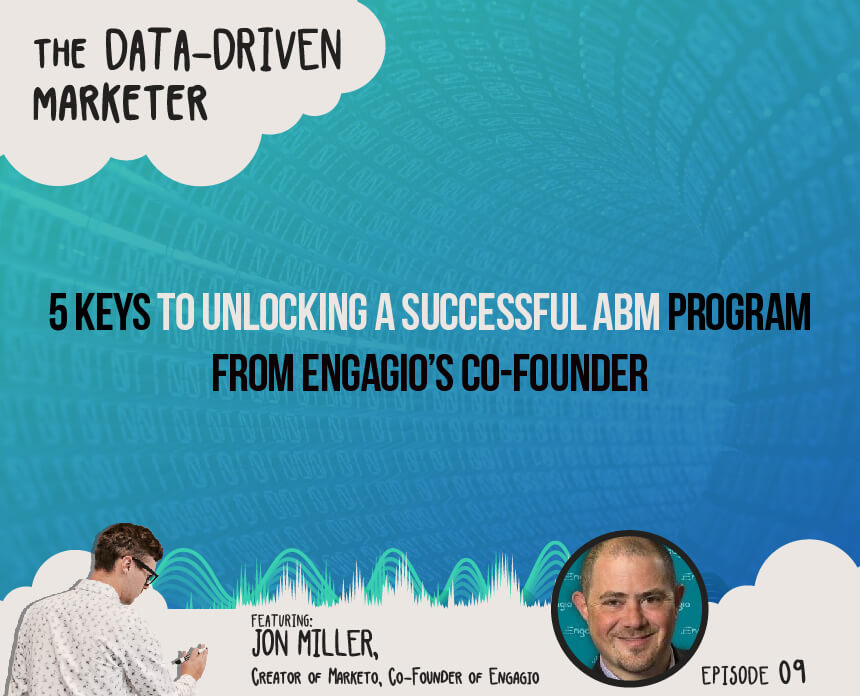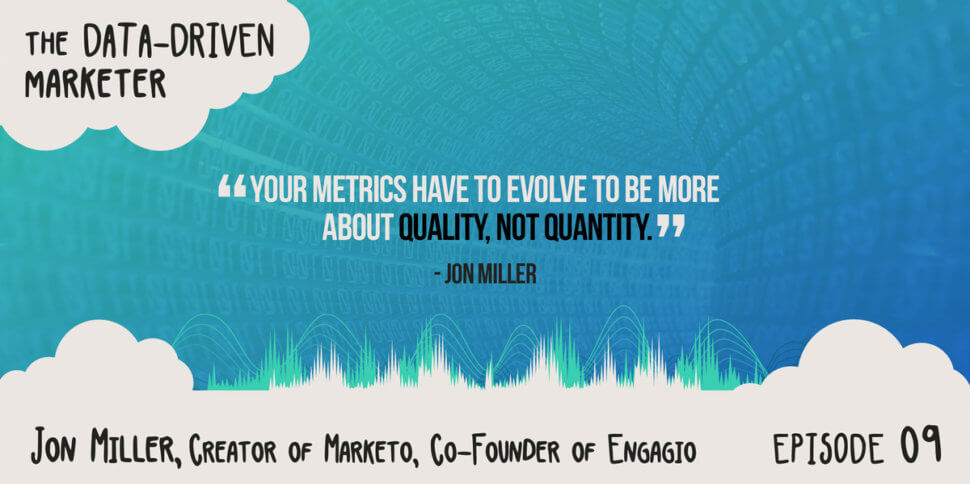
5 keys to unlocking a successful ABM program with Engagio’s Jon Miller
Sales and marketing hand-offs in a nice, linear fashion are great, but don’t expect that in the ABM world.
Your gameplan has to be much more agile and adaptable to lock down the accounts that matter.
CEO and co-founder Engagio and previous co-founder at Marketo, Jon Miller, shares his knowledge about what works in ABM.
We explore:
- The role of the modern marketer
- ABM mistakes to avoid
- Must-dos for successful account-based marketing
ABM: An increasingly non-linear process
It’s no surprise that modern sales and marketing processes look a little different than they used to.
Hand-offs between marketing and sales were typically straightforward. It was a matter of communication and having the right automation tools in place.
Now, it’s not so simple. With ABM on the rise, teams are looking at more complex gameplans to acquire large-scale accounts—with more opportunities for ABM mistakes.

Instead of a baton hand-off in a relay race, sales and marketing alignment looks a little more like a soccer game. While the ball may be passed forward, backward, and sideways to each player on the team, the overarching goal remains the same: land that big account.
To understand this better, we need to redefine the modern marketer’s job.
- Marketers used to send cold emails and generate top-of-the-funnel leads. Now, sales teams need to invest the time to scope out the right target accounts and be more targeted.
- Marketers have bigger roles later in the selling game. Big accounts have numerous decision-makers that all need to be targeted. Marketers have the skills to target these personas with relevant content.
- The dramatic rise in recurring revenue models call marketers to focus on post-sale processes. Keeping—and upselling—current customers is as vital as acquiring new ones.
It’s apparent that the marketer’s role is evolving in response to a non-linear sales and marketing process. To stay current, and avoid ABM mistakes, it’s essential to address these changes proactively.

Jon offers marketers five expert tips for implementing a successful account-based marketing (ABM) program.
1. Marketing and sales should pick target accounts together for ABM
Instead of the marketing team collecting target accounts and handing them off to sales, make it a team effort.
By finding target accounts together, the sales rep will be more excited to get involved. It’s important to recognize they have their own valuable insights into the industry.
After fleshing out what an ideal account looks like, don’t forget to enter it into your sales and marketing databases. Jon emphasizes that any worthy account that meets the set criteria should be in your database. (That means you may need to purchase additional data from multiple third-parties.)
Choosing target accounts together also promotes team alignment. One way to maintain this cohesion is to facilitate weekly or bi-weekly meetings between the marketing and sales rep. This way, you’ve accounted for all touchpoints and the prospect receives a better experience.
2. Put personalization at the core
Jon has seen many organizations using much too broad of approaches when starting out in ABM. It might seem scary at first, but if the targeted accounts meet all of your criteria, it should pay off to focus on just a few.
One ABM mistake Jon sees is companies relying too heavily on digital ads. You may bring in more traffic, but it’s unlikely the few accounts you really want are going to make any commitment based on an ad.
Ways to stand out through personalization include:
- A case study featuring a client that’s similar to your prospect (created especially for them)
- Branded desk accessories
- Acting as a consultant instead of an ordinary sales/marketing person
- Handwritten letters
- Meeting followup gifts (gift cards, mugs, desk plants, etc.)
It’s also important to note that you’re targeting actual people, not just the brand. Find out how those decision-makers prefer to communicate.
3. Figure out your ABM metrics
It’s essential to establish new KPIs before switching over to ABM. Your old methods of measuring success won’t make sense and can lead to ABM mistakes.
Jon gives the example of setting a goal for the number of leads a piece of content is generating. If you’re truly focused on just a few big accounts, why be concerned with the number of leads you’re bringing in?
Set goals and KPIs that are conducive to ABM.

4. Treat ABM like a strategy
Oftentimes, companies mistake ABM for a campaign and not a fundamental strategy. The issue with this is that once you finally land an account, you still need to live up to the standard that your new client is used to.
Especially since recurring revenue models are becoming increasingly popular, you need to be able to offer the same—if not, more—value on a regular basis.
Successful account-based marketing (ABM) is not something that has an ending like a campaign. It should be interwoven into your entire organization’s strategy.
5. Automate lead-to-account matching
As long as you’ve entered the ideal account criteria into your database, Jon suggests automating lead-to-account matching to keep everything straight. You want to make sure you’re routing and scoring correctly, and to do this, you need to match a lead to a target account.
It’s a marathon, not a sprint
ABM can seem frustrating at first. Longer sales cycles and more focused work can be exhausting. However, as long as your team puts in the necessary work and research, that first big fish will be well worth the wait.

Comments (0)
Ahmad yaqub
Oct 25, 2022 at 10:18 AM
Enter comments I want to be able business
Reply